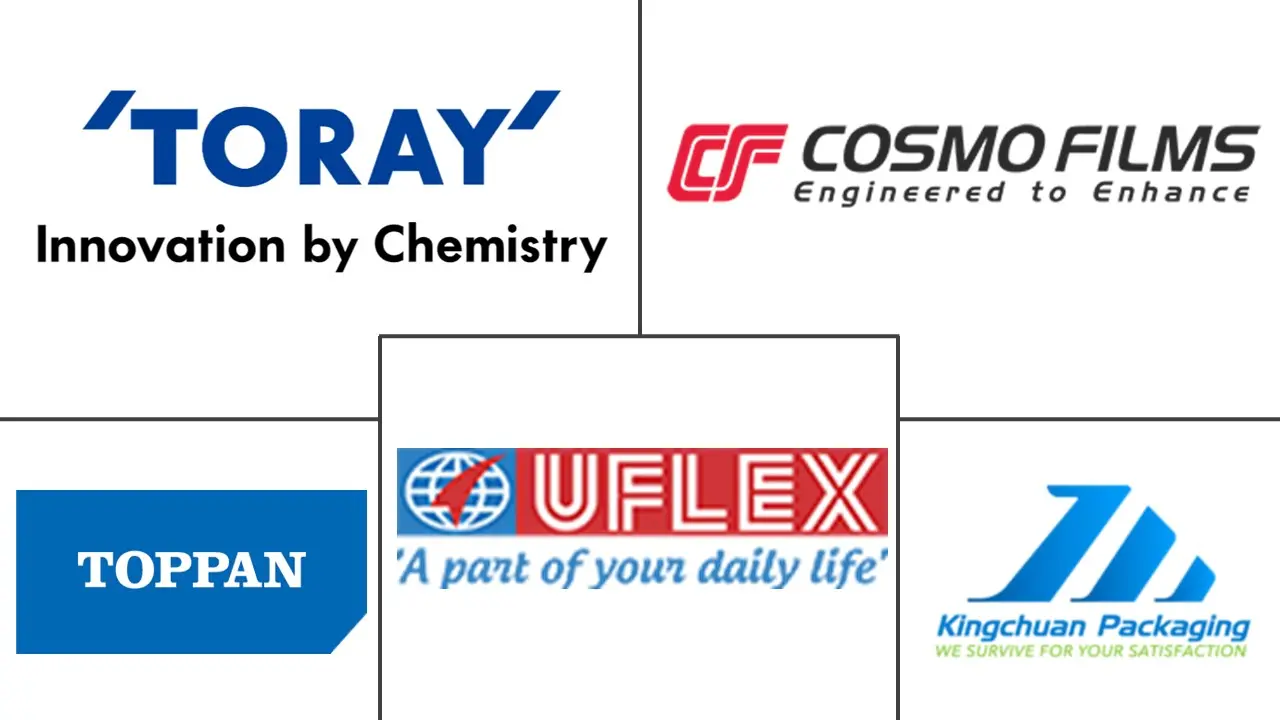Asia Pacific Plastic Packaging Film Market Size and Share
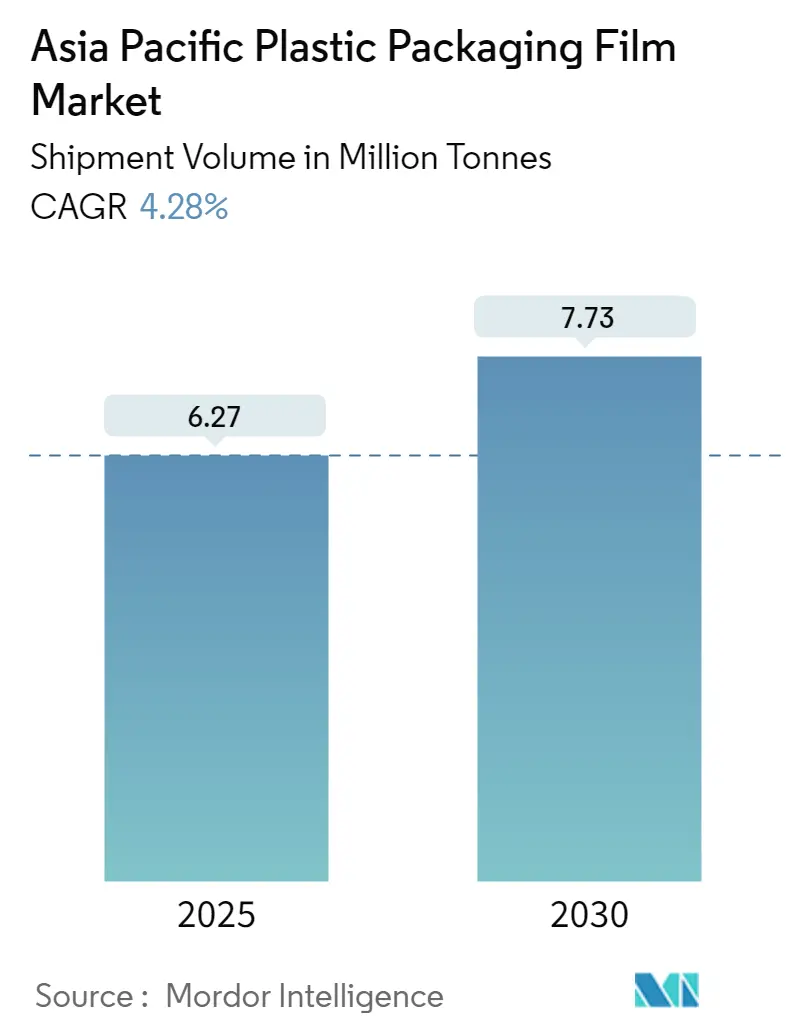
Asia Pacific Plastic Packaging Film Market Analysis by Mordor Intelligence
The Asia Pacific Plastic Packaging Film Market size in terms of shipment volume is expected to grow from 6.27 million tonnes in 2025 to 7.73 million tonnes by 2030, at a CAGR of 4.28% during the forecast period (2025-2030).
- Asia-Pacific is poised to dominate the global flexible plastic packaging market in the coming years. Rapid urbanization, escalating disposable incomes, and a rising appetite for packaged foods can be attributed to this growth. The retail sector's swift expansion is bolstering the market. The surge in consumer goods available through e-commerce platforms amplifies the need for packaging films. These films are crucial in e-commerce, ensuring products are portable, secure, and durable.
- Asia-Pacific is significant in the global plastic films and sheets market, with China spearheading the demand. With both China and India showing consistent growth, Asia-Pacific is poised to retain its leading position globally. The surge in the consumption of ready-to-eat meals is fueling the demand for safe and eco-conscious packaging.
- The food and beverage industry is a primary consumer of plastic film packaging. This industry is pivoting toward eco-conscious packaging solutions. The market exhibits fragmentation; major players are actively creating innovative, cost-effective solutions to cater to evolving consumer needs.
- In January 2023, Ester Industries Limited (Ester Filmtech Limited) announced the commencement of commercial production at Telangana's new polyester (BOPET) film manufacturing facility. The 48,000 MTPA unit spans 50 acres and costs around INR 650 crore (USD 78.5 million). When the factory operates at its peak efficiency, it is anticipated to provide revenue of about INR 600 crores (USD 72.62 million). The products resulting from this new unit will primarily be utilized in the flexible packaging sector and contribute to expanding the flexible packaging sector's value chain.
- The retail sector in the Asia-Pacific region is vibrant and varied, with a range of formats such as supermarkets, hypermarkets, convenience stores, traditional shops, and online platforms. Given that the region hosts some of the world’s largest and swiftest-growing economies, its retail sector is thriving. In the Asia-Pacific region, the retail sector is poised to play a pivotal role in propelling the growth of the flexible packaging film market.
- The market faces challenges from evolving regulatory standards driven by mounting environmental apprehensions. In response to public awareness about plastic packaging waste, the federal governments of several countries like India and China are rolling out stringent regulations to curtail environmental harm and enhance waste management. This heightened environmental consciousness, coupled with concerns over single-use plastics and unsustainable business models, is prompting consumers to seek products with reduced environmental footprints.
Asia Pacific Plastic Packaging Film Market Trends and Insights
The Rising Demand for BOPP Films Aids Market Growth
- Biaxially oriented polypropylene (BOPP) is a thin plastic film that undergoes mechanical and manual stretching through a cross-direction process. Due to its versatile properties, BOPP films have surged in popularity across the region. Their applications are universal, including soft drink six-packs, bottle labels, and plastic bags. Noteworthy for their high tensile strength and enhanced stiffness, BOPP films are a staple in various everyday products.
- BOPP is a rapidly growing film material due to its exceptional versatility. As a polypropylene film, BOPP is a superior substitute for waxed paper and aluminum foil. It has a higher tensile strength, a stiffer modulus, lower elongation, superior gas barrier properties, and reduced haze compared to cast polypropylene (CPP). Moreover, BOPP films are readily accessible in various finishes, including matte, glossy, and silky matte.
- BOPP films find extensive applications in the pharmaceutical and cosmetic industries. They excel in their sealing properties and act as an effective oxygen barrier. With India and China's pharmaceutical and cosmetic industries witnessing robust growth, the demand for BOPP films is further bolstered. Notably, a primary concern in these sectors is oxidation, a challenge that BOPP films adeptly combat.
- According to the National Bureau of Statistics of China, the retail sales value of beauty and cosmetic products in China increased from USD 41 billion in 2019 to USD 56.94 billion in 2023. This increasing trend is expected to continue in the upcoming years, increasing the demand for BOPP films.
- Several firms have invested in expanding and growing their production on the market. The market for BOPP barrier films has increased due to the growing demand for packaged food goods for packaging, food safety, and transportation. Significant investments are being made in the industry.
- In June 2023, Toray Industries, in response to the surging demand from the electric vehicle (EV) sector, is set to boost its production capacity for Torayfan BOPP film at its Tsuchiura facility in Japan's Ibaraki prefecture. The expansion, slated for completion in 2025, is expected to increase capacity by a significant 40%.
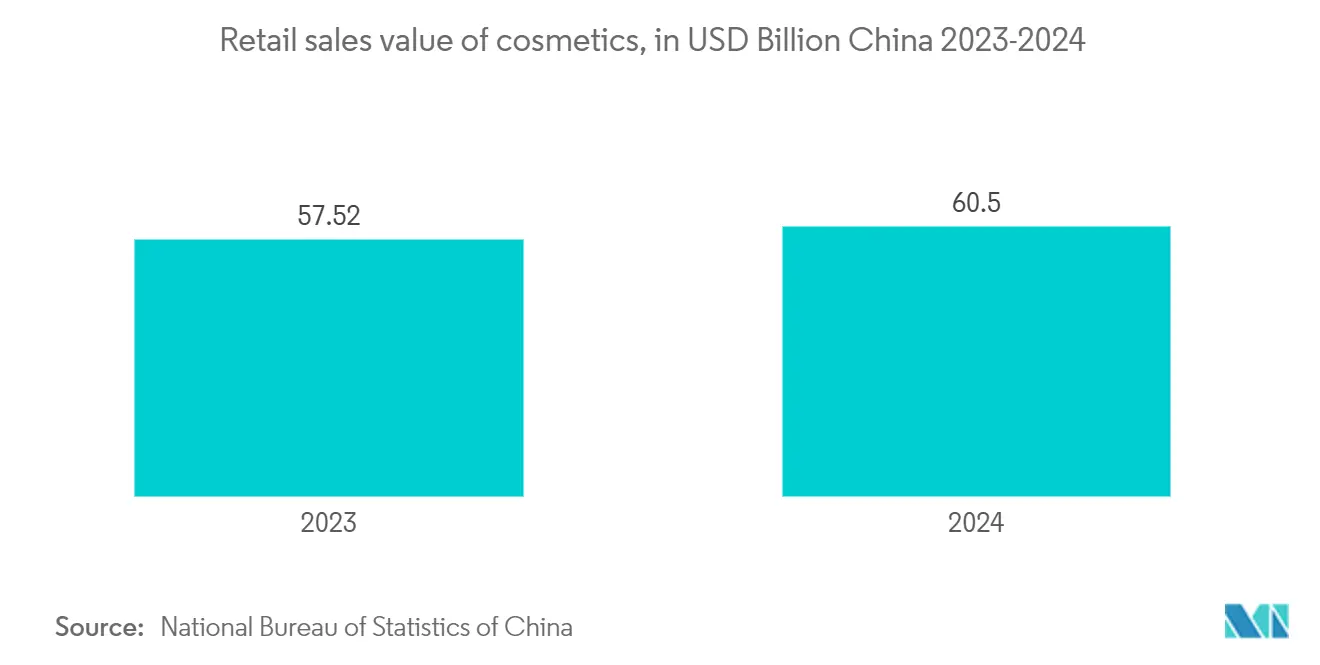
Demand is Expected to Increase in India
- The Indian frozen foods and snacks market is growing, propelled by evolving lifestyles and shifting consumer preferences. Frozen vegetables and snacks dominate, accounting for over 65% of the market share. Noteworthy brands such as Mother Dairy, Venky's, and McCain Foods lead the market. Frozen snacks, particularly, are experiencing robust double-digit growth, favored for their convenience, making them a go-to choice for impromptu home or office purchases.
- As Thomas Schneider, president of the World Packaging Organization (WPO), highlighted, the Indian packaging market is poised for substantial growth in the coming years. This can be attributed to the heightened emphasis on clean water, safe food, and pharmaceuticals, along with the swift adoption of cutting-edge digital technologies.
- The vast and increasing Indian middle-income group and the expansion in organized retail drive growth in the flexible packaging market. The growth of fishery and seafood exports also boosts the demand for converted plastic film packaging.
- According to the Reserve Bank of India, in fiscal year 2023, India's export value of fish and fishery products surpassed INR 649 billion, marking a substantial increase from the preceding year. With the gradual increase in fishery products and fish exports, the demand for high-barrier plastic packaging films would also increase.
- Market players are increasingly focusing on integrating innovative features such as enhanced tear resistance, improved barcode clarity, superior load retention, water resistance, and heightened impact strength. The surge in demand from the retail sector and an escalating emphasis on product packaging and ensuring goods' safety during distribution and warehousing are poised to be pivotal growth catalysts for the stretch films market.
- In April 2024, to address the easing demand for stretch films nationwide, Chemco Group, a key player based in Mumbai, Maharashtra, strengthened its market position with the launch of its cutting-edge stretch film line. This technology, boasting an annual production capacity exceeding 1,000 tons, empowers businesses to cater to the escalating demand without compromising film quality.
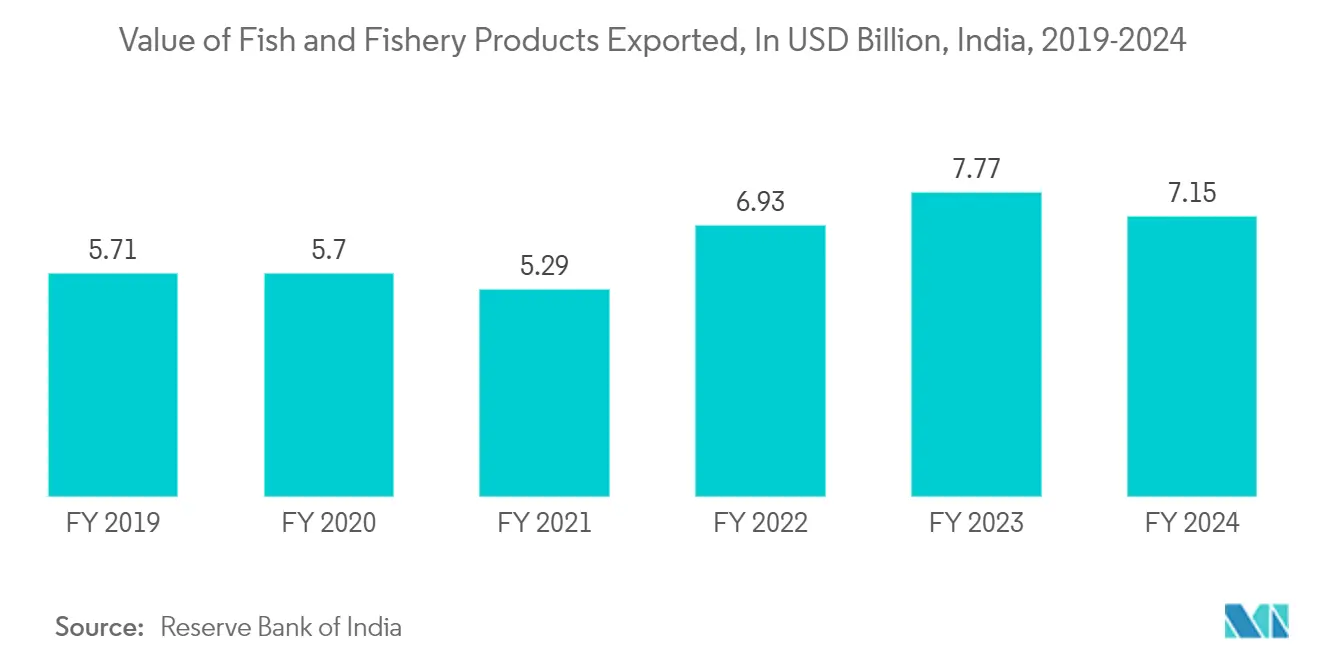
Competitive Landscape
The Asia-Pacific plastic packaging film market is fragmented. The major market players include Toray Advanced Film Co. Ltd, Berry Global Inc., and UFlex Limited. The market comprises major and local players supplying raw materials and packaging services.
- April 2024: UFlex Limited secured a long-term power purchase agreement (PPA) with Amplus Phoenix Private Limited. This agreement was specifically tailored for UFlex's packaging films plant in Karnataka. As part of its commitment to achieving net-zero emissions by 2035, or even earlier, UFlex aims to slash its carbon footprint by an estimated 19,000 tCO2e significantly.
- March 2024: TOPPAN Inc., a wholly owned subsidiary of TOPPAN Holdings Inc., in collaboration with India's TOPPAN Speciality Films Private Limited (TSF), unveiled GL-SP, a cutting-edge barrier film utilizing biaxially oriented polypropylene (BOPP) as its base. This innovative product is set to join the esteemed lineup of sustainable packaging solutions under the TOPPAN Group's GL BARRIER1 series. TOPPAN and TSF commenced sales of GL-SP in April 2024, targeting the packaging of dry goods primarily in the Indian and other Asian markets.
Asia Pacific Plastic Packaging Film Industry Leaders
Toray Advanced Film Co. Ltd
Kingchuan Packaging
UFlex Limited
Cosmo Films Limited
Toppan Packaging Service Co., Ltd.
- *Disclaimer: Major Players sorted in no particular order
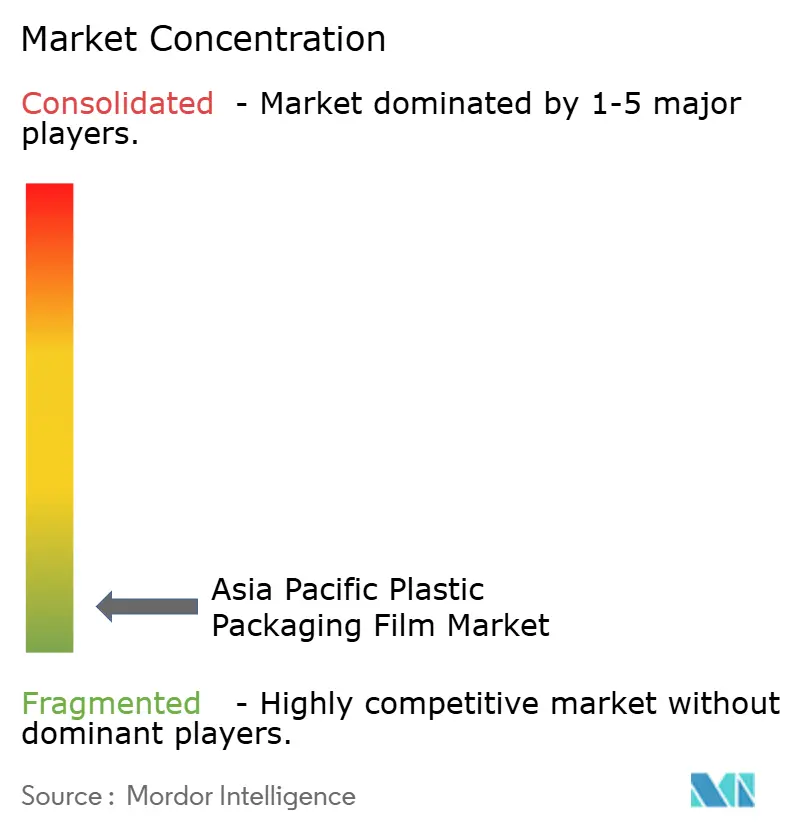
Recent Industry Developments
- March 2024: Shantou Mingca Packaging, a leading shrink film manufacturer, and ExxonMobil Asia Pacific Research & Development jointly unveiled a cutting-edge shrink film solution. This innovative product, based on double-bubble polyethylene (PE) technology, is expected to revolutionize the market. Utilizing the ultra-low density Exceed XP performance PE, this next-gen polyolefin shrink film (POF) promises superior performance and sustainability. The film is also versatile. The film caters to a broad spectrum of products, ranging from personal care items and electronics to medicines and household goods.
- August 2023: TOPPAN, Mitsui Chemicals Tohcello, and Mitsui Chemicals launched a collaborative pilot. This pilot aims to commercialize a technology focused on horizontally recycling packaging films. The initiative was part of a broader effort by three Tokyo-based plastics companies to test a novel approach: recycling printed biaxially oriented polypropylene (BOPP) film into fresh, flexible packaging material.
Asia Pacific Plastic Packaging Film Market Report Scope
Plastic films are thin, continuous materials typically wound on a core or cut into sheets. The study tracks the demand for converted packaging films across the major resin and application types. The analysis delves into various film types, including polypropylene (PP), polyethylene film (PE), polyethylene terephthalate films (PET), polystyrene films (PS), bio-based, and other variants. The segmentation extends to encompass end-user industries and specific countries.
The Asia-Pacific plastic packaging film market is segmented by type (polypropylene (biaxially oriented polypropylene (BOPP) and cast polypropylene (CPP)), polyethylene (low-density polyethylene (LDPE) and linear low-density polyethylene (LLDPE)), polyethylene terephthalate (biaxially oriented polyethylene terephthalate (BOPET)), polystyrene, bio-based, and PVC, EVOH, PETG, and other film types) and end user (food [candy & confectionery, frozen foods, fresh produce, dairy products, dry foods, meat, poultry, and seafood, pet food, and other food products], healthcare, personal care & home care, industrial packaging, and other end users). The market sizes and forecasts are provided in terms of volume (units) for all the above segments.
| Polypropylene (Biaxially Oriented Polypropylene (BOPP), Cast polypropylene (CPP)) |
| Polyethylene (Low-Density Polyethylene (LDPE), Linear low-density polyethylene (LLDPE)) |
| Polyethylene Terephthalate (Biaxially Oriented Polyethylene Terephthalate (BOPET)) |
| Polystyrene |
| Bio-Based |
| PVC, EVOH, PETG, and Other Film Types |
| Food | Candy & Confectionery |
| Frozen Foods | |
| Fresh Produce | |
| Dairy Products | |
| Dry Foods | |
| Meat, Poultry, And Seafood | |
| Pet Food | |
| Other Food Products | |
| Healthcare | |
| Personal Care & Home Care | |
| Industrial Packaging | |
| Other End-use Industry Applications |
| China |
| India |
| Japan |
| Thailand |
| Australia and New Zealand |
| Indonesia |
| Vietnam |
| By Type | Polypropylene (Biaxially Oriented Polypropylene (BOPP), Cast polypropylene (CPP)) | |
| Polyethylene (Low-Density Polyethylene (LDPE), Linear low-density polyethylene (LLDPE)) | ||
| Polyethylene Terephthalate (Biaxially Oriented Polyethylene Terephthalate (BOPET)) | ||
| Polystyrene | ||
| Bio-Based | ||
| PVC, EVOH, PETG, and Other Film Types | ||
| By End User | Food | Candy & Confectionery |
| Frozen Foods | ||
| Fresh Produce | ||
| Dairy Products | ||
| Dry Foods | ||
| Meat, Poultry, And Seafood | ||
| Pet Food | ||
| Other Food Products | ||
| Healthcare | ||
| Personal Care & Home Care | ||
| Industrial Packaging | ||
| Other End-use Industry Applications | ||
| By Country | China | |
| India | ||
| Japan | ||
| Thailand | ||
| Australia and New Zealand | ||
| Indonesia | ||
| Vietnam | ||
Key Questions Answered in the Report
How big is the Asia Pacific Plastic Packaging Film Market?
The Asia Pacific Plastic Packaging Film Market size is expected to reach 6.27 million tonnes in 2025 and grow at a CAGR of 4.28% to reach 7.73 million tonnes by 2030.
What is the current Asia Pacific Plastic Packaging Film Market size?
In 2025, the Asia Pacific Plastic Packaging Film Market size is expected to reach 6.27 million tonnes.
Who are the key players in Asia Pacific Plastic Packaging Film Market?
Toray Advanced Film Co. Ltd, Kingchuan Packaging, UFlex Limited, Cosmo Films Limited and Toppan Packaging Service Co., Ltd. are the major companies operating in the Asia Pacific Plastic Packaging Film Market.
What years does this Asia Pacific Plastic Packaging Film Market cover, and what was the market size in 2024?
In 2024, the Asia Pacific Plastic Packaging Film Market size was estimated at 6.00 million tonnes. The report covers the Asia Pacific Plastic Packaging Film Market historical market size for years: 2020, 2021, 2022, 2023 and 2024. The report also forecasts the Asia Pacific Plastic Packaging Film Market size for years: 2025, 2026, 2027, 2028, 2029 and 2030.
Page last updated on:
Asia Pacific Plastic Packaging Film Market Report
Statistics for the 2025 Asia Pacific Plastic Packaging Film market share, size and revenue growth rate, created by Mordor Intelligence™ Industry Reports. Asia Pacific Plastic Packaging Film analysis includes a market forecast outlook for 2025 to 2030 and historical overview. Get a sample of this industry analysis as a free report PDF download.
